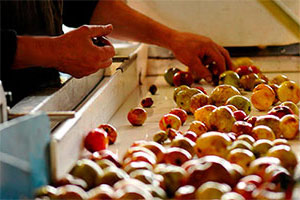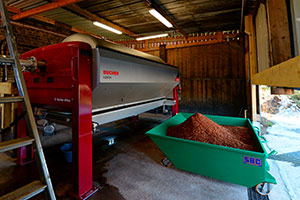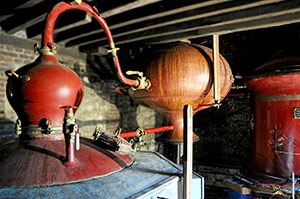The Making of Cider and Calvados
To preserve the purest expression of the apple and its terroir
The apples are washed and sorted: just before being pressed, the fruit travel along a sorting table where they are verified manually. Apples showing signs of rot are discarded. If this has become common nowadays in cider making, it is still very rare amongst ciders destined to be distilled to create calvados.
The apples are pressed in a specially modified membrane press normally used in winemaking. The grated apples are stirred frequently throughout the slow extraction at low pressures. In contradistinction to the more traditional presses, which provide a lot of pressure in one place, using this technique, the skin and pulp are uniformly pressed, sufficiently gently and slowly for the must to receive all the aromas the apples can provide.
Cider
Fermentation will subsequently continue in vats. A passage in a closed vat (Closed Tank Charmat method) allow a perfect control of the natural effervescence on selected yeasts.
This cider that we consider stable, can be kept up to 5 years when the bottles are stored in good conditions, bottles if possible upright in a dry environment at température inferior to 15°C (60° F).
Calvados
Cider destined to become calvados is aged six months on its lees to enrich its aromatic expressiveness. This is the perfect time span to avoid any tainting (deviation/corruption). The distillation can then begin.
In the early '80s Etienne Dupont went to study the double distillation
methods used to make Cognac. He was thus
able to adapt the golden rules born of
a long tradition of excellence. He subsequently
kept on improving them so as to obtain the most perfect possible result.
The estate's
alembic allows the distillation to take
place flexibly and with precision. Double
distillation is essential to receive
the AOC "Calvados du Pays d'Auge".
(To find out more about calvados
distillation...)
The calvados is then aged in casks: new oak casks that were only lightly
heated for the first three months, where the calvados gains hints of
vanilla, then in older casks for long aging, where its flavours intensify
and become more complex. The most volatile alcohols evaporate slowly.
The calvados progressively approaches its final sipping strength.
(To
find out more about calvados aging...)
Cider destined to become calvados is aged six months before the double distillation, the same as used to make Cognac.






